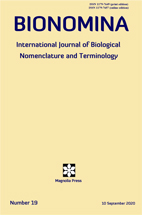Abstract
The genus nomen Larifuga Loman, 1898 was originally published without stated grammatical gender. No possible indications of gender are provided by the specific epithets, as all of them are nouns in the genitive. This genus nomen has consistently been treated as feminine in the literature. However, as shown here, it is a masculine classical Latin word. Accordingly, several matches are herein made to comply with Latin grammar and the Code. The nomen Larifuga mantoni Lawrence, 1934 was subject to an unjustified emendation by Staręga as mantonae, and the original form is re-established here. This correction raised another issue concerning previous unjustified emendations of some nomina in Opiliones formed from personal names in the genitive case.
References
Anonymous [International Commission on Zoological Nomenclature] (1905) Règles internationales de la nomenclature zoologique. International rules of zoological nomenclature. Internationale Regeln der zoologischen Nomenklatur. Paris (F. R. de Rudeval): 1–57, 3 leaves.
Anonymous [International Commission on Zoological Nomenclature] (1999) International code of zoological nomenclature. Fourth edition. London (International Trust for zoological Nomenclature): i–xxix + 1–306.
Anonymous [United Nations Human Rights Council] (2020) Office of the United Nations High Commissioner for Human Rights. Free and Equal United Nations. Factsheet on intersex. <https://www.unfe.org/wp-content/uploads/2018/10/Intersex-English.pdf/ accessed on 2nd March 2020>.
Brandon-Jones, D., Duckworth, W., Jenkins, P. D., Rylands, A. B. & Sarmiento, E. E. (2007) The genitive of species-group scientific names formed from personal names. Zootaxa, 1541: 41–48. <https://doi.org/10.11646/zootaxa.1541.1.4>.
Dubois, A. (2000) Synonymies and related lists in zoology: general proposals, with examples in herpetology. Dumerilia, 4: 33–98.
Dubois, A. (2007) Genitives of species and subspecies nomina derived from personal names should not be emended. Zootaxa, 1550: 49–68. <https://doi.org/10.11646/zootaxa.1550.1.2>.
Dubois, A. (2018) The correct spelling of the nomen Nyctimystes cheemani Tyler, 1964 (Amphibia, Anura), with some comments on Latin grammar and the Rules of the Code. Alytes, 35 (1‒4): 75‒84.
Guérin-Ménéville, F. E. (1837) Livraison 45, Arachnides (pl. 2, 4, 5, 6). In: Planches des animaux invertebrés; in: Iconographie du Règne Animal de Cuvier ou Représentation d’après nature de l’une des espèces les plus remarquables et souvent non encore figurées de chaque genre d’animaux, ‘1829‒1844’, Paris (J. B. Baillière), Vol. 2: [i], pl. 1‒226.
Kauri, H. (1961) Opiliones. In: B. Hanström, P. Brinck & G. Rudebeck (ed.), South African animal life, Results of the Lund University Expedition in 1950-1951, Vol. 8, Uppsala (Almquist & Wiksell): 9–197.
Kuper, L. E., Nussbaum, R. & Mustanski, B. (2012). Exploring the diversity of gender and sexual orientation identities in an online sample of transgender individuals. Journal of Sex Research, 49 (2–3): 244–254. <https://doi.org/10.1080/00224499.2011.596954>.
Kury, A. B. (2017) Conflicting synonymies and secondary homonyms in some Indo-Malayan genera of Gagrellinae (Opiliones, Eupnoi, Sclerosomatidae). Rivista aracnologica italiana, 15: 35–46.
Kury, A. B. & Cokendolpher, J. C. (2000) Opiliones. In: E. González Soriano, J. Llorente Bousquets & N. Papavero (ed.), Biodiversidad, taxonomía y biogeografía de Artrópodos de México: hacia una síntesis de su conocimiento, Vol. 2, México, D.F. (UNAM, Facultad de Ciencias): 137–157.
Lawrence, R. F. (1931) The harvest-spiders (Opiliones) of South Africa. Annals of the South African Museum, 29 (2): 341–508.
Lawrence, R. F. (1934) New South African Opiliones. Annals of the South African Museum, 30 (4): 549–586.
Lee, P. A., Houk, C. P., Ahmed, S. F., & Hughes, I. A. (2006). Consensus statement on management of intersex disorders. Pediatrics, 118 (2): 488–500. <https://doi.org/10.1542/peds.2006-0738>.
Loman, J. C. C. (1898) Beiträge zur Kenntniss der Fauna von Süd-Afrika. Ergebnisse einer Reise von Prof. Max Weber im Jahre 1894. IV. Neue Opilioniden von Süd-Afrika und Madagaskar. Zoologische Jahrbücher, Abteilung für Systematik, Ökologie und Geographie der Tiere, Jena, 11: 515–530, pl. 31. < https://doi.org/10.5962/bhl.part.26904>.
Marcellino, I. (1973) Notizie su Opilioni (Arachnida) italiani e dell’Alto Isonzo. Annali del Museo civico di Storia naturale di Genova, 79: 192–205.
Olson, D. M., Dinerstein, E., Wikramanayake, E. D., Burgess, N. D. Powell, G. V. N., Underwood, E. C., D’Amico, J. A., Itoua, I., Strand, H. E., Morrison, J. C., Loucks, C. J., Allnutt, T. F., Ricketts, T. H., Kura, Y., Lamoreux, J. F., Wettengel, W. W., Hedao, P. & Kassem, K. R. (2001) Terrestrial ecoregions of the world: a new map of life on earth. BioScience, 51 (November 2001): 933–938. <https://doi.org/10.1641/0006-3568(2001)051[0933:TEOTWA]2.0.CO;2>.
Pocock, R. I. (1902) Some points in the morphology and classification of the Opiliones. The Annals and Magazine of natural History, (7), 10 (60): 504–516. <https://doi.org/10.1080/00222930208678711>.
Pocock, R. I. (1903) On some new harvest-spiders of the order Opiliones from the southern continents. Proceedings of the zoological Society of London, ‘1902’, 2 (6): 392–413.
Roewer, C. F. (1911) Übersicht der Genera der Subfamilie der Phalangiini der Opiliones Palpatores nebst Beschreibung einiger neuer Gattungen und Arten. Archiv für Naturgeschichte, (Abt. A: Original-Arbeiten), 77 (Supplementheft 2): Berlin: 1–106, pl. 1–3.
Roewer, C. F. (1912) Revision der Opiliones Palpatores (= Opiliones Plagiostethi). II. Teil: Familie der Phalangiidae. (Subfamilien: Sclerosomini, Oligolophini, Phalangiini). Abhandlungen aus dem Gebiete der Naturwissenschaften, herausgegeben vom Naturwissenschaftlichen Verein in Hamburg, 20 (1): 1–295, pl. 1–4.
Roewer, C. F. (1923) Die Weberknechte der Erde. Systematische Bearbeitung der bisher bekannten Opiliones. Jena (Gustav Fischer): 1–1116.
Schwendinger, P. J. & Martens, J. (2002) A taxonomic revision of the family Oncopodidae III. Further new species of Gnomulus Thorell (Opiliones, Laniatores). Revue suisse de Zoologie, 109 (1): 47–113. <https://doi.org/10.5962/bhl.part.79580>.
Shear, W. A. (2008) Deletions from the North American harvestman (Opiliones) faunal list: Phalangomma virginicum Roewer, 1949 is a synonym of Erebomaster weyerensis (Packard, 1888) (Travunioidea: Cladonychiidae), and a note on ‘Crosbycus’ goodnightorum Roewer, 1951 (Nemastomatidae). Zootaxa, 1945: 67–68. <https://doi.org/10.11646/zootaxa.1945.1.4>.
Staręga, W. (1966) Beitrag zur Kenntnis der Weberknecht-Fauna (Opiliones) der Kaukasusländer. Annales zoologici, Warsawa (Polska Akademia Nauk), 23 (13): 387–411.
Staręga, W. (1989) A new species of Larifuga Loman from the Cape Province, South Africa (Opiliones: Triaenonychidae). Annals of the Natal Museum, 30: 9–13.
Staręga, W. (1992) An annotated check-list of harvestmen, excluding Phalangiidae, of the afrotropical region (Opiliones). Annals of the Natal Museum, 33 (2): 271–336.

